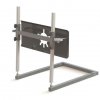Its been issue'd before but can't find the link to it.
I have bumpsteer issues on my KVA B chassis which I am trying to sort. I allready raised the steering rack by 12mm ( about 7/16 ).
I have seen ball joint extenders to extrent the tie rod from the steering arm ( not to extend it from the track rod).
I prefer the ball joint extender over a rose joint conversion but any leads to a rose joint conversion will do. track rod side is M14x2.
Cortina mk3 rack & tie rods.
I have bumpsteer issues on my KVA B chassis which I am trying to sort. I allready raised the steering rack by 12mm ( about 7/16 ).
I have seen ball joint extenders to extrent the tie rod from the steering arm ( not to extend it from the track rod).
I prefer the ball joint extender over a rose joint conversion but any leads to a rose joint conversion will do. track rod side is M14x2.
Cortina mk3 rack & tie rods.

